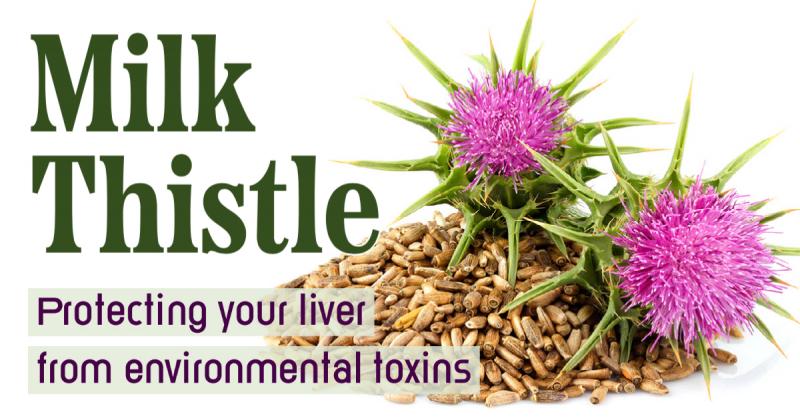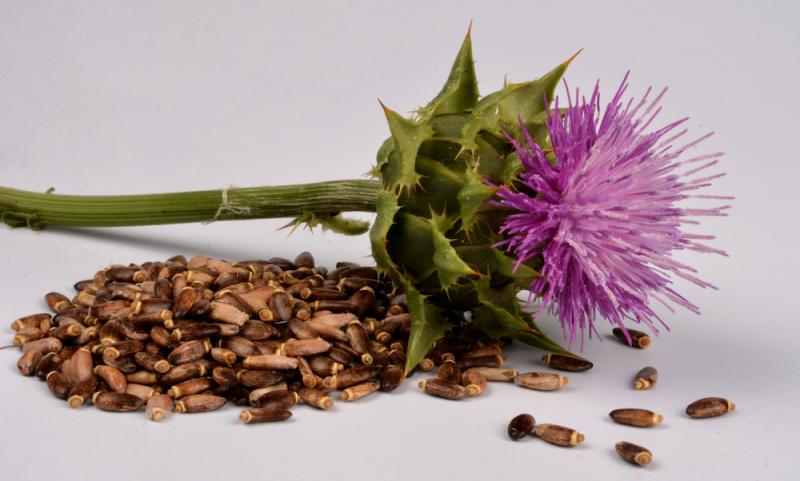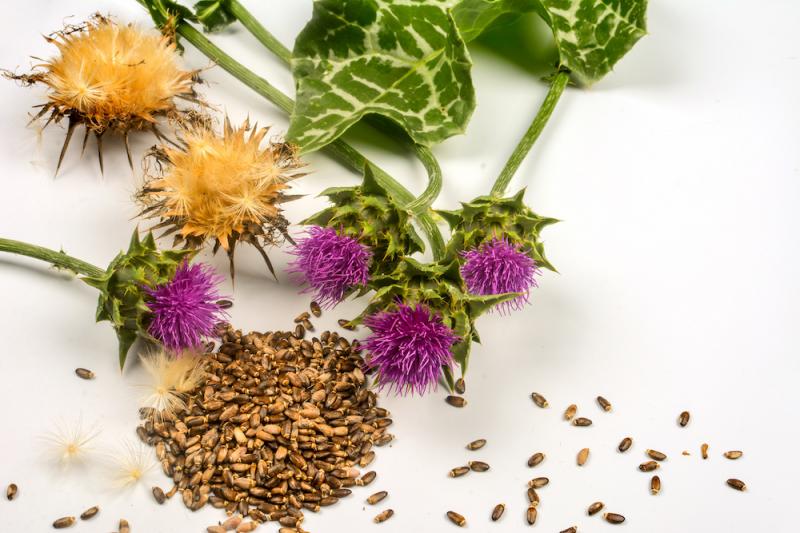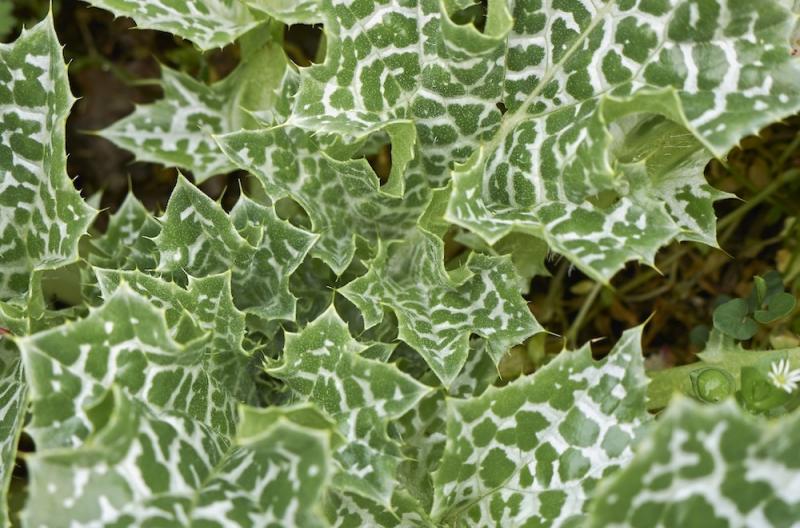
I was first introduced to milk thistle, Silybum marianus, while attending a convention down under. An Australian naturopath told me how wonderful St. Mary’s thistle, AKA milk thistle, was for protecting the liver. He was using it to protect a swim team against the chlorine and chemicals in the pool and it had improved the athletic performance of every member of the team. Today milk thistle is widely recognized for its ability to protect the liver from chemical poisoning.
Both common names come from the milky white markings on the leaves. The name St. Mary’s Thistle comes from an association of these markings with the milk from the Virgin Mary. One of the traditional uses of this remedy has been using the leaves to improve breast milk production in lactating women.
Hepatoprotective Properties
 Milk thistle seeds, the part used in modern herbalism, contain a group of compounds (flavonolignans) collectively called silymarin. Silymarin contains compounds like silybin, silychristin, silydianin and isosilybin. It is these compounds that appear to give milk thistle its primary liver benefits. The seeds contain 1.5% to 3% of these compounds, and the industry standard is to selectively extract these compounds to concentrate them rather than use the whole herb. You can find standardized extracts that contain as much as 80% silymarin. This can be convenient, but, you don’t need a standardized extract to get results.
Milk thistle seeds, the part used in modern herbalism, contain a group of compounds (flavonolignans) collectively called silymarin. Silymarin contains compounds like silybin, silychristin, silydianin and isosilybin. It is these compounds that appear to give milk thistle its primary liver benefits. The seeds contain 1.5% to 3% of these compounds, and the industry standard is to selectively extract these compounds to concentrate them rather than use the whole herb. You can find standardized extracts that contain as much as 80% silymarin. This can be convenient, but, you don’t need a standardized extract to get results.
Silymarin has been shown to protect liver cells from chemicals and toxins. Examples of compounds milk thistle will protect the liver from include alcohol, tetracycline, acetaminophen, thallium, erythromycin, amitriptyline, and carbon tetrachloride. It can also reduce side effects from chemotherapy. Silymarin also raises glutathione levels in the liver, which scavenges free radicals also helping to protect the liver.
Antidote to Death Cap Mushrooms
Milk thistle is even used in hospitals in Europe to treat poisoning from Amanita (death cap) mushrooms. These mushrooms are deadly poisonous because as the liver attempts to get rid of the poison in them via the gallbladder, they are readily reabsorbed and taken back to the liver. Each time they are processed by the liver, they do more damage to the liver cells.
Matthew Wood tells a story about saving a friend's life who had eaten some of these mushrooms in his Book of Herbal Wisdom. When he arrived at her home she was lying on the bathroom floor drifting in and out of consciousness. He had her chew up a quarter ounce of milk thistle seeds as he transported her to the hospital. Giving her the milk thistle while getting her to the hospital saved her life.
Milk Thistle and the Liver
 Milk thistle increases bile flow, helping the body digest fats. It also lowers cholesterol in the process. It’s helpful for many kinds of liver problems, too. It can help people who are experiencing serious liver diseases like hepatitis and cirrhosis of the liver. It can even help to reverse some of the damage done to the liver by alcohol and other harmful substances.
Milk thistle increases bile flow, helping the body digest fats. It also lowers cholesterol in the process. It’s helpful for many kinds of liver problems, too. It can help people who are experiencing serious liver diseases like hepatitis and cirrhosis of the liver. It can even help to reverse some of the damage done to the liver by alcohol and other harmful substances.
However, the best use of milk thistle is not after these serious diseases start, but before they begin, when a person is experiencing moderate liver dysfunction, a problem not recognized in modern Western medicine, but described clearly in many systems of traditional herbalism. Many Americans have symptoms of moderate liver dysfunction but don’t recognize it for what it is.
Understanding Moderate Liver Dysfunction
In TCM, the liver is said to harmonize the body functions, and problems with the liver result in vague and confusing symptoms. However, the clearest indications I’ve seen include all of the following, headaches (including migraines), skin problems, problems with venous circulation (including varicose veins and hemorrhoids), brain fog, nervous energy in the evening making it difficult to go to sleep, a groggy hung-over feeling in the morning, feeling generally irritable, and going to many doctors or healers who have trouble figuring out what’s wrong.
I first learned about moderate liver dysfunction from the book Diet and Nutrition by Dr. Rudolph Ballentine. He said that it this type of patient, whom a “busy and baffled doctor” is most likely to call a hypochondriac. He also points out that they have made a correct diagnosis without realizing it because the liver is located in an area of the body known anatomically as the hypochondrium.
Michael Moore’s Metaphors
In Medicinal Plants of the Desert and Canyon West, Michael Moore paints a metaphorical picture of functional liver problems in his discussion of milk thistle. Here’s what he has to say.
Stated another way, a functional liver disease is like leaving the thermostat up to high on your central heater. If the heat is on all the time, the energy costs can get staggering and the heater either burns out from constant, unrelenting use or the gas company turns it off when you can’t pay the bill. In both cases, the functional has become the organic; it’s broken or you can’t afford to pay the bill because you are broke. Milk thistle helps lower the thermostat, clean the vents, blow off junk from the air filters, etc.
 Later he continues with this explanation of the link between circulatory problems and a congested liver.
Later he continues with this explanation of the link between circulatory problems and a congested liver.
When the liver is overworked, or unequal to the task our brain gives it, its blood vessels enlarge, the fluids move more slowly through it as it tries to increase its work area; it gets enlarged and congested. Blood trying to get in backs up, this is called portal hypertension. The portal vein (really a misplaced artery) draws blood from the intestinal tract and spleen; if the blood can’t get in fast enough, the blood drawn from closer tissues goes in first and the other blood backs up. The farther from the liver, the more the backup.
In mild portal hypertension, blood from the colon and pelvis can bypass through smaller veins into the general circulation. As these veins aren’t large enough, the returning blood from the legs gets backed up going into them. With all that used junk blood from the colon going through them, they enlarge, balloon out, and become venosities and vericosities. And so it goes, with pelvic congestion, hemorrhoids, hydroceles, chronic urethritis, enlarged prostate and cervix, eventually with leg varicosities. Milk thistle helps.
Recommending Milk Thistle
I highly recommend milk thistle, or more often a formula containing it, to individuals who work around chemicals. This includes but is not limited to, janitors, carpet cleaners, beauticians, hairdressers, house painters, dry cleaners, auto mechanics, print shop workers, builders, farmers, gardeners, and welders. For these purposes, milk thistle combines well with gentle liver-supportive herbs like dandelion, burdock, and red clover, as well as nutrients like vitamin C, n-acetyl-cysteine, and alpha lipoic acid. Milk thistle is considered an invasive weed, so there's no reason not to harvest it if you find it growing near you. You can use either the leaves or seeds, but the most hepatoprotective part is the seeds. Considering the many toxins present in the modern world, it's a good remedy to have on hand and perhaps even use regularly.
Downloads
Steven's Articles
-

-
The Sensible Use of Caffeinated Herbs
Kola nuts, guarana, and yerba mate and other herbs…
-

-
The Health Benefits and Problems with Coffee
This popular caffeinated beverage can be beneficial…
October
-

-
Understanding Caffeine & Cellular Adaptation
Preserving the power of caffeine's buzz and the…
September
-

-
Horseradish
A pungent spice for aiding protein metabolism…
-

-
Banaba or Crepe Myrtle
A beautiful tree from Southeast Asia whose leaves…
August
-

-
Monkeyflowers
Flower essences to help see ourselves more clearly…
-

-
Mariposa Lilies
Strengthening the bond between mother and child…
-

-
The Noble Bay Leaf
A common kitchen herb for aiding digestion and…
-

-
Epimedium: Horny Goat Weed
A circulatory stimulant and kidney yang tonic…
July
-

-
The Medicinal and Nutritional Benefits of Apricots
A nutritious fruit and valuable medicinal seed for coughs
-

-
Dogwoods
Asian dogwood is used to stop excessive discharge,…
June
-

-
Neem: The Village Pharmacy
A popular Ayurvedic remedy for dental and immune…
-

-
Spilanthes: The Toothache Plant
A traditional remedy for teeth and gums, as well…
-

-
Forsythia
An anti-inflammatory, fever-reducing, and infection fighting herb
May
-

-
Buckwheat (Kashi)
A delicious, high protein, gluten-free, gut-healthy food

